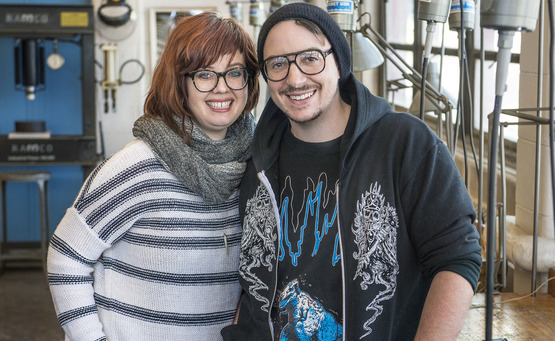Rich & Austin Zarobell | Jewelry Designers and Visiting Artists
Designing a career: Jewelry + Metals grads advise current students
Jewelry designers Rich & Austin (Bates) Zarobell were visiting artists at the Cleveland Institute of Art.
Rich & Austin Zarobell’s story is one of motivation, perseverance, and taking risks.
The New York jewelry designers came back to their alma mater in mid-January to share their story and encourage current students to work hard and take risks of their own.
Rich and Austin (Bates) Zarobell met at Cleveland Institute of Art where Austin graduated in 2007, and Rich in 2008, both with BFAs in Jewelry + Metals. They married in 2012.
After graduating, both started their careers at Heather Moore Jewelry, the Cleveland-based high-end jewelry design firm founded by 1993 grad Heather Moore. Both said they gained valuable skills at Heather Moore Jewelry but – like Moore herself after her graduation – the Zarobells had their sights set on New York City.
They made the move on New Year’s Day in 2010 after Rich was hired by award-winning designer Alexis Bittar. Austin had a few different jobs, initially, before finding her fit designing jewelry for Showroom35 under license for Vince Camuto and Louise et Cie.
For both, New York was a big adjustment.
“The move was huge,” said Austin who grew up in Kansas. “There was really a lot to get used to. They don’t have grocery stores. And you can’t really drive a car.”
Rich had a similar experience. “It’s really scary being unfamiliar with your surroundings,” he added.
During a public talk at CIA in mid-January, Austin explained that the move to New York isn’t for everybody. “We’ve seen people fail. But we didn’t. We were lucky; things worked out for us.”
While both are working in the same industry, there is a defined difference between their jobs.
“The client base is different. Different demographic,” Rich said. “Mine is geared more towards high fashion,” he said of Alexis Bittar. By contrast, Austin’s work at Showroom35 is more accessible to mass market customers.
Austin and Rich have both had positive experiences working on a team to design under one brand. “For me I think it’s a fun challenge to interpret someone else’s aesthetic through your own filter and find something that’s going to please your boss, and please the sales team, and the stores, and ultimately the consumer,” Austin said.
Rich spoke to the breadth of experimentation that comes with working for someone else. “It’s a little freeing. I have more freedom material-wise, cost-wise. I can experiment with scenarios I wouldn’t be able to afford with my own work.”
“It forces me to think about things I wouldn’t necessarily think about if I was on my own,” he added. After several years working at Alexis Bittar, he has moved up the ladder and currently serves as the team leader for the Miss Havisham and Elements collections.
The Zarobells both say their experiences at CIA have had an “immeasurable” impact on their careers.
“It taught me about problem solving,” Rich said. “I learned how to learn, and in a way how to teach myself.” After graduating, Rich taught himself additional computer design programs so he could bulk out his portfolio with new renderings.
Austin said she appreciates her CIA background in art history and art materials. “Just having a broad view of the possibilities of what materials you can work in, and having a historical perspective have also been useful,” she said. “I was definitely interested in jewelry, but I also wanted a broader experience to make sure there wasn’t something else that appealed to me even more.” At CIA she and Rich were able to explore other areas of art, taking classes in enameling, drawing, and 3d modeling.
“They don’t force you to wear blinders, like other schools. You’re allowed to explore other mediums and departments,” Rich added. “That’s just super valuable.”
Their advice for students pursuing fashion jewelry-making, “Obsess over fashion,” Austin said. “Consume fashion.”
Rich added, “Consume as much as you can and just try to immerse yourself. And know the Adobe programs.”
Their advice for all students of art and design boils down to: never stop working.
“Internships, internships, internships,” Rich said. “When I see somebody has had an internship, I can tell they’re willing to work and they’re dedicated.”
During their public presentation Austin said, “People think that three to four years out they’re going to be working their dream job. That’s just not what happens. But that’s ok, because during those years in between you learn so much, and you need that time to really grow.”
Text by Alyssa Brown.
Text and Image courtesy CIA News.
Alyssa Brown is a marketing intern at CIA.
